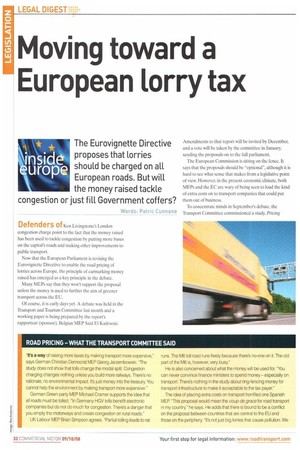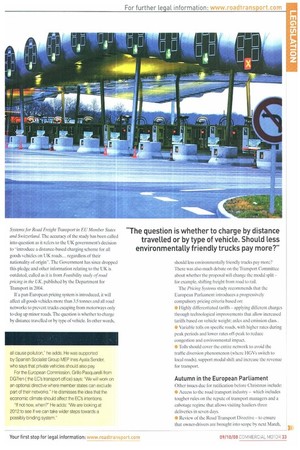Moving toward a European lorry tax
Page 32

Page 33

Page 34

If you've noticed an error in this article please click here to report it so we can fix it.
The Eurovignette Directive proposes that lorries should be charged on all European roads. But will the money raised tackle congestion or just fill Government coffers?
Words: Patric Cunnane
Defenders of Ken Livingstone's London congestion charge point to the fact that the money raised has been used to tackle congestion by putting more buses on the capital's roads and making other improvements to public transport.
Now that the European Parliament is revising the Eurovignette Directive to enable the road pricing of lorries across Europe, the principle of earmarking money raised has emerged as a key principle in the debate.
Many MEPs say that they won't support the proposal unless the money is used to further the aim of greener transport across the EU.
Of course, it is early days yet. A debate was held in the Transport and Tourism Committee last month and a working paper is being prepared by the report's rapporteur (sponsor), Belgian MEP Said El Kadraoui. Amendments to that report will be invited by December, and a vote will be taken by the committee in January, sending the proposals on to the full parliament.
The European Commission is sitting on the fence. It says that the proposals should be "optional", although it is hard to see what sense that makes from a legislative point of view However, in the present economic climate, both MEPs and the EC are wary of being seen to load the kind of extra costs on to transport companies that could put them out of business.
To concentrate minds in September's debate, the Transport Committee commissioned a study, Pricing Systems for Road Freight Transport in EU Alember States and Switzerland, The accuracy of the study has been called into question as it refers to the UK government's decision to "introduce a distance-based charging scheme for all goods vehicles on UK roads... regardless of their nationality of origin". The Government has since dropped this pledge and other information relating to the UK is outdated, culled as it is from Feasibility study of road pricing in the UK, published by the Department for Transport in 2004.
If a pan-European pricing system is introduced, it will affect all goods vehicles more than 3.5 tonnes and all road networks to prevent trucks escaping from motorways only to clog up minor roads. The question is whether to charge by distance travelled or by type of vehicle. In other words, should less environmentally friendly trucks pay more? There was also much debate on the Transport Committee about whether the proposal will change the modal split — for example, shifting freight from road to rail.
The Pricing Systems study recommends that the European Parliament introduces a progressively compulsory pricing criteria based on: • Highly differentiated tariffs — applying different charges through technological improvements that allow increased tariffs based on vehicle weight; axles and emission class.
• Variable tolls on specific roads, with higher rates during peak periods and lower rates off-peak to reduce congestion and environmental impact.
• Tolls should cover the entire network to avoid the traffic diversion phenomenon (where HGVs switch to local roads), support modal shift and increase the revenue for transport.
Autumn in the European Parliament
Other issues due for ratification before Christmas include: • Access to the road transport industry — which includes tougher rules on the repute of transport managers and a cabotage regime that allows visiting hauliers three deliveries in seven days.
• Review of the Road Transport Directive — to ensure that owner-drivers are brought into scope by next March, meaning that they will be subject to the 48-hour average working week and other provisions of the directive.
• The Temporary Agency Workers Directive expected to be signed off giving agency workers full employment rights after 12 weeks.
The crowded legislative programme means that some laws may fall until after next June's European Parliament elections. One MEP told CM that there will he a temptation to deal with less complicated proposals in the next few months.
Stephen Hughes, UK Labour MEP sits on the Employment and Social Affairs Committee and is hoping the issue of owner-drivers will be dealt with. "1 was initially the rapporteur on this. We worked to ensure there was no way round the law for unscrupulous employers," he says.
"in 2002 we built in a review period and expected the EC to support bringing in owner-drivers next March. Unfortunately, so far it has waffled." He adds that rapporteur Spanish MEP Alejandro Cercas has the support of the Socialists. Liberals and Greens for the proposal.
Hughes is confident the Temporary Agency Workers Directive will be adopted this autumn. "We hope it will be straightforward. Agency workers will have the same rights as employees after 12 weeks." He accepts this will mean that many agency workers will not benefit but says it is the price that may have to be paid. "The UK Government says 12 weeks will cover 70% of workers."
He believes the directive will be adopted in a European Parliament plenary session in November and become law across the EU in 2011.
He is, however, worried about the churning effect, where employers take on one agency worker for 11 weeks and replace him with another before he gains employee entitlements. "The directive has no safeguards, but there will be a review five years after implementation." •








































































































































































